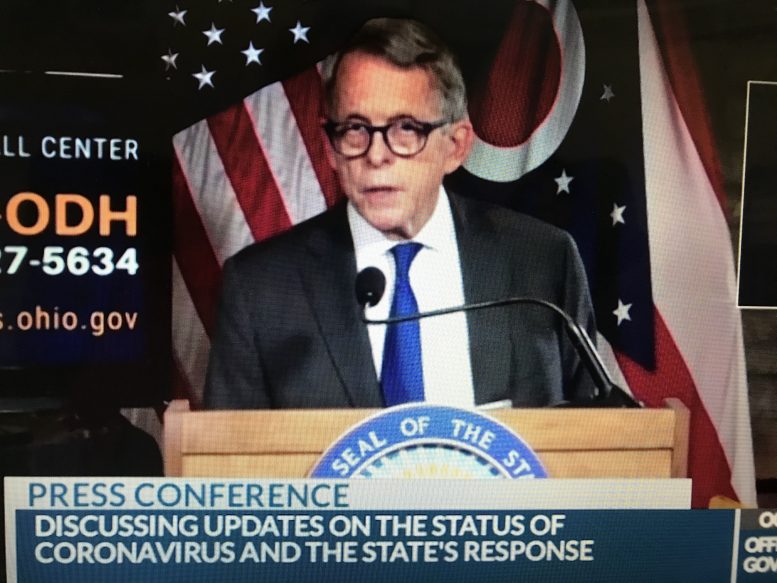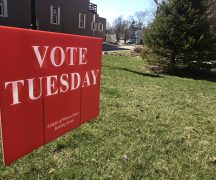Thursday was Ohio’s worst day of the pandemic and all evidence suggests things are likely to worsen, according to interviews and new state data.
Nearly 2,200 new COVID-19 infections were reported Thursday, the state’s third record breaking day this week alone.
There are 1,041 Ohioans in the hospital with COVID-19 — about 100 shy of the all-time high set in late July. The COVID-19-hospitalized population has nearly doubled since mid-September.
“We’ve gone up dramatically in a relatively short period of time,” Gov. Mike DeWine said to reporters Thursday.
The good news: More Ohioans than ever are being tested for the new coronavirus. The bad news: The rate at which those tests are coming back positive has doubled since Sept. 23, a sign the virus is growing more prevalent.
Thirteen new counties turned red this week indicating “very high exposure and spread” on the Ohio Public Health Advisory System — a product of seven inputs like hospital visits, outpatient care visits in a county, population-adjusted infection rates and others. Twenty-nine counties are red, spanning about two-thirds of the state’s population.
“What you’re seeing in today’s numbers should get our attention,” DeWine said. “There’s a red tide flowing all over the state of Ohio.”
DeWine said some of the newly-turned red counties are slated to host community events like political rallies, pub crawls and social gatherings and that “now is really the time to rethink whether these are in the best interest of the community.”
He did not address his own administration’s decision to exempt recent rallies for President Donald Trump from the statewide mask requirement.
While DeWine said there are no plans in store for any kind of statewide stay-at-home order, he declined to promise against instituting the policy down the line.
All told, nearly 176,000 Ohioans have contracted COVID-19. Nearly 17,000 have been hospitalized, and 5,038 have died since March.
In red counties, health department staff said they continue to see spread at family gatherings like bonfires, birthday parties and barbeques.
Jennifer Hiestand, a public information officer at the Zanesville-Muskingum County Health Department, estimated 60% of people in public are wearing masks. Contact tracers have found “mini outbreaks” that are seemingly the result of people letting their guards down.
“People just made the decisions not to social distance or not to wear a mask, those things that they probably should have,” she said.
Mahoning County Health Commissioner Ryan Tekac said he is seeing a lot of the county’s progress this summer start to erode as cold weather drives people inside.
“I think there are some concerns right now that individuals are putting their guards down,” he said.
Ohio’s recent case surge fits in with a national trend. The New York Times reports cases are trending upward in 41 states, especially in the Midwest.
Two holidays are coming up that will test Ohio’s public health discipline — Halloween and Thanksgiving.
Tekac said there’s a lot of concern, especially with Thanksgiving, about the potential for outbreaks. However, he said people know the guidance; wear masks, keep your distance, wash your hands, outside is better than inside.
He said at a certain point it comes to individuals making their own good decisions.
Dr. Anthony Fauci, the top infectious disease expert at the National Institute of Health, told CBS News it’s an “unfortunate fact” that Thanksgiving will cause a lot of spread and suggested skipping out on the tradition this year.
“I think given the fluid and dynamic nature of what’s going on right now and the spread and uptick of infections, I think people should be very careful and prudent about social gatherings,” he said.
***
Also from Ohio Capital Journal:
State financial report shows declines in unemployment, personal income
Despite decreases in most economic growth categories, including personal income, a monthly financial report said Ohio’s economic recovery was ahead of the national recovery.
The September report prepared by the Ohio Office of Budget and Management said the state was at 87% on an index tracking economic recovery, developed by research firm Moody’s Analytics and CNN. The index rates states and the nation on 62 indicators of economic activity, and ranging from no economic activity to 100% of pre-pandemic levels.
The “back-to-normal index” placed the nation at 81.2% recovery.
Unemployment dropped in the state in August, but remained at 8.9%, above the national average of 7.9%. Unemployment in Ohio has also increased slightly the past three weeks. READ MORE
Ohio AG, city prosecutors oppose ban on no-knock warrants, instead want to enhance standards
Ohio Attorney General Dave Yost and three city prosecutors acknowledged Thursday that no-knock warrants are very rare in the state, but say the tool shouldn’t be banned, just clarified.
Yost and prosecutors from Franklin, Cuyahoga and Hamilton counties held a press conference Thursday announcing a push for changes to the statute regarding no-knock search warrants.
“The no-knock is designed for rare occasions when there’s a serious problem, a serious issue of officer safety where if you knock on the door and say ‘police,’ they might answer the door with a burst of automatic weapons fire,” Yost said.
With that in mind, Yost plans to send a letter to leaders of the Ohio General Assembly and Gov. Mike DeWine asking them to clarify aspects of the no-knock warrant statute.
Yost said Ohio’s status as a Castle Doctrine state also complicates things, because the doctrine allows Ohioans to use force in their home if they feel it is being threatened. The new measure would require proof of a “substantial risk” of harm to officers, rather than the statute’s current language of “risk of serious physical harm.” READ MORE





